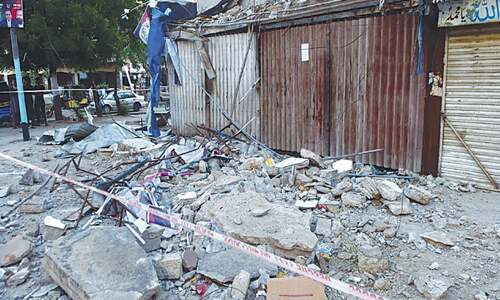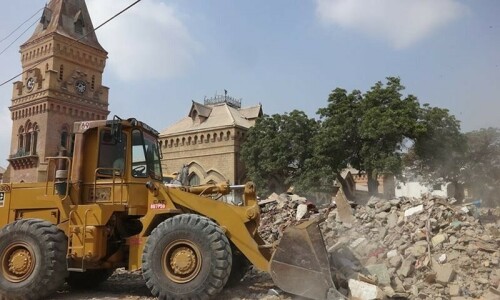KARACHI: Use of imported coal in a proposed 660-megawatt power generation project raised concern at a public hearing on Monday, as the government was asked to immediately devise a short-term policy to ensure use of indigenous coal resources for electricity production.
Participants in the meeting were earlier informed that coal for the power project of Lucky Electric Power Company (LEPC), part of Lucky Cement Limited, would be imported from Indonesia, South Africa, and/or Australia.
The LEPC project site is spread over 250 acres in Deh Ghangiaro in Bin Qasim Town near the Port Qasim area, where similar coal-fired power projects are at different stages of approval or construction.
The hearing was held as required under the Sindh Environmental Protection Act, 2014.
During the question-answer session, Dr Mirza Arshad Ali Baig, former director general of the Pakistan Council of Scientific and Industrial Research who is heading the EIA (Environmental Impact Assessment) team of the project, regretted that power policy had been politicised and the government failed to come up with a viable plan to make use of local coal resources.
Despite facing the energy crisis since the 1990s, the local coal had not been utilised to produce electricity, he said. “We are already too late in utilising local coal as a cheap source of generating electricity that the country so desperately requires.
“There is an immediate need for a short-term government policy and investment in research to make use of the huge coal reserves especially the ones we have in Thar,” he said.
The government decision to go for imported coal for industrial purposes was wrong, he added.
LEPC chief executive Intesar Haqqi, however, explained reasons why the company preferred imported coal to the Thar coal in its project. He argued that among other hiccups, the high transportation cost was a major reason behind the decision.
“Firstly, the Thar coal is not available in the market. Secondly, we have been importing coal for cement manufacturing from South Africa for the past many years.
“We spend 14 paisa per tonne per kilometre to bring the coal from South Africa to Karachi by sea. But the road journey from Thar to Karachi will involve expenses of Rs1,750 per tonne per kilometre. In fact it will be much higher given the fact that water content in Thar coal is high,” he said.
The process of making Thar coal viable for energy uses, he said, required investment of more than a billion rupees and an entrepreneur would do that only if he was assured that there was an attractive market available to sell his product.
As a first step, he continued, the government needed to develop what he described as a ‘coal culture’. “The expansion of coal-based industries would encourage parties to invest in Thar coal exploration.”
Plant amidst population
Another major concern highlighted during the programme was related to the LEPC coal-based power project site. It was stated the plant was being established in an area where major residential-cum-commercial projects have been planned by private investors.
Besides, questions were also raised about the type and content of the coal to be used in the project, proper ash storage and disposal and its impact on ecology.
“There is a need for a study to examine the cumulative environmental impact of all coal-based fired power plants to be built or being constructed in the Port Qasim area or near it,” said Sindh Environmental Protection Agency Director General Naeem Ahmed Mughal.
Earlier justifying the project, Mr Haqqi briefed the audience about the present global energy trends and said that despite the fact that 43pc of world electricity was generated through coal, its use had been neglected in Pakistan.
“Currently, we are facing a gas shortage of two billion cubic feet and producing 36pc of our energy through residual fuel oil, which is expensive. The present low oil prices are a real threat and will further lead to pressure on Pakistan’s exchequer,” he said.
Liquefied natural gas (LNG) was also a costly bridging option, he said. However, he added, coal was a sustainable option as world coal reserves, estimated to be 890bn metric tonnes, were available in different parts of the world.
Elaborating upon the same line of argument, Syed Nadeem Arif of EMC said that unlike other countries where coal was the largest source for power generation, for instance India 68pc, China 79pc, South Africa 93pc, he said, coal’s contribution in the energy mix was almost none (0.1pc).
“Pakistan is currently facing an electricity shortage of 6,000MW to 7,000MW that results in eight to 20 hours of load-shedding, under-employment, reduced investment and loss of production,” he said.
Saquib Ejaz Hussain of EMC highlighted the salient features of the project and some key points of its EIA report. He said the LEPC project was based on state-of-the-art super-critical thermal technology with a 200-meter high chimney had systems for emissions control, seawater flue gas desulfurization (FGD) system, wastewater treatment, dust suppression, continuous emission monitoring, coal unloading, ash handling and disposal and storage facilities.
“Environment protection measures have been undertaken in accordance with the Environment Protection Guidelines of World Bank / International Finance Corporation and Environmental Protection and Emission Control Standards of Sindh EPA,” he claimed.
Published in Dawn, October 27th, 2015
On a mobile phone? Get the Dawn Mobile App: Apple Store | Google Play














































